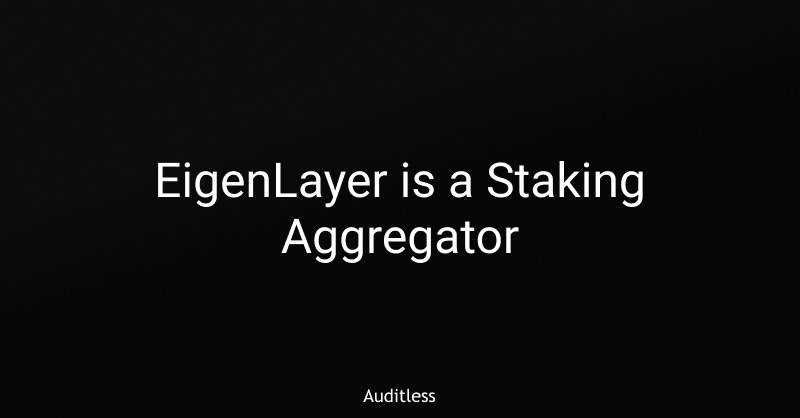EigenLayer is a Staking Aggregator
Time is running out for the competition.
My introduction to eigenvalues was in a Cambridge Maths classroom as part of a pretty stable and historic curriculum.
It's curious that the term reappears in a much more dynamic context.
EigenLayer cannot even be explained without covering Ethereum staking which only launched in 2020.
While it's all very new, the concept of reusing a stake for the purposes of providing decentralized trust will likely become one of the cornerstones of the modern financial system.
While the mechanism has been well dissected, the protocol strategy behind EigenLayer is surprisingly interesting and I wanted to talk about it, continuing our series on Aggregator Protocols.
What is EigenLayer
I recommend reading the Whitepaper and watching the Bankless and Bell Curve podcasts to learn more.
But here's the TL:DR anyways.
Ethereum security relies on stakers being decentralized (many entities that would find it difficult to collude) and economically invested (putting up a significant economic stake that incentivizes accurate validation).
Other mechanisms involving off chain operators may desire these properties as well but it’s hard to bootstrap a sufficiently decentralized and economically significant staker set.
This is where EigenLayer comes in. Mechanism designers may build what’s called an Actively Validated Service (AVS) and EigenLayer makes it convenient for both Ethereum node operators and stakers to restake their positions and provide security for this new service.
This also provides a third occasionally desirable property, which is that the stakers are already Ethereum aligned insofar as they secure Ethereum blockspace.
Who benefits
In short?
Everyone?
AVS Developers
Protocol developers that create an AVS get a robust codebase of contracts for staking, delegation and slashing.
(EigenLayer integration tests are a nice example of how robust the protocol is.)
They also get EigenSDK, a software development kit for building operator tooling.
Both native and liquid staking is supported and requirements may be imposed on stakers to prioritize a specific version of trust.
Operators
Operators who actually perform the validation also get increased security, knowing that the AVS developer is using EigenLayer contracts and the SDK.
Next, they receive UX benefits of being able to operate and receive rewards in a uniform way across different AVS's.
Finally, a veto committee is in place that can protect and recover funds if they get slashed due to a bug in an AVS.
Stakers
Stakers get a uniform platform for restaking and capital efficiency of reusing their staked ETH and staking to multiple AVS's simultaneously.
Where aggregation happens
The past 12 months has been a season of these Aggregator Protocols. We already covered an AMM aggregator and two lending aggregators.
EigenLayer fits this lens very well.
The capital efficiency of restaking is the primary economic source of aggregation.
This is further protected as EigenLayer does not elect to wrap staked positions into any fungible tokens which does make it harder for new staking services to create further wrappers around EigenLayer staked assets.
Put in simpler terms, existing ETH that is restaked through EigenLayer cannot be restaked further in the way that EigenLayer restakes ETH that is already staked on Ethereum.
The power of aggregation theory is that it helps us reason about what protocol changes will contribute to the aggregator moat and which ones won't.
Other validator pools
There is no reason that only assets containing ETH/stETH can be aggregated.
The EigenLayer system could be extended to contain a fourth role: a validator pool.
ETH stakers could be the initial validator pool but others could be supported in the future.
However, this is not as appealing as it first sounds.
This validator pool would by definition use a distinct type of capital and validator set and therefore not share in the capital efficiency benefits.
There would be some benefits on applications being able to rely on dual staking for additional security, however, that would also create some bifurcation as multiple validator pools may dilute the aggregation moat around the current validator pool.
It’s unlikely that a second validator pool would make sense to launch soon unless it was strictly secondary/subservient to the primary staker pool on Ethereum.
How quickly can EigenLayer grow
Operators and stakers are more easily recruited.
While some of them are principled and strictly stake to add additional security for Ethereum, the sheer level of concentration in LSTs proves that a lot of them aren't philosophically motivated.
These entities will be attracted by the opportunity to earn additional yield and the fact that EigenLayer already has a points system.
It’s the AVS developers that are the hardest to attract. Not every day a developer wakes up to create a new oracle network or DA layer.
And being a first mover, capturing the mindshare of the crypto community and early momentum with twelve early adopters already announced in August.
The competitive response will be even more interesting to watch.
Liquid staking platforms like Lido may feel threatened by the direct relationship EigenLayer will build with the restakers and may be pressured to introduce their own restaking solutions.
The irony of crypto is that every company simultaneously is trying to decentralize and while aggregating and centralizing a specific relationship (as they should).
We’ve found that for EigenLayer as well.
The system aims to monopolize the power to slash Ethereum validators.




